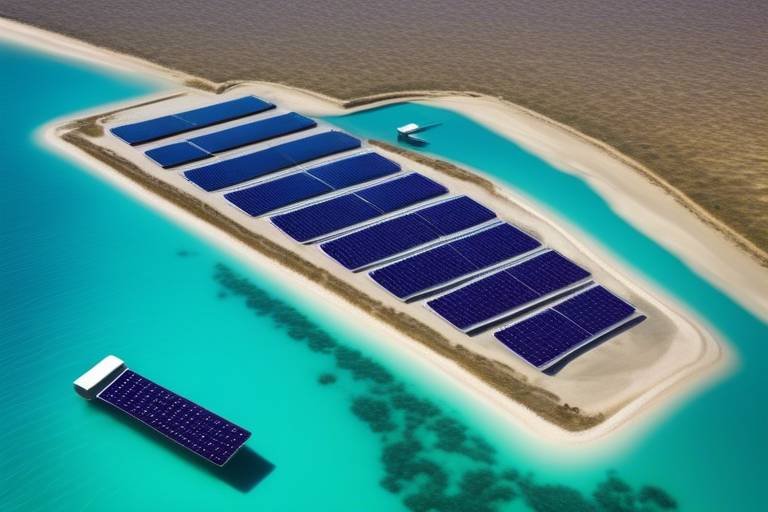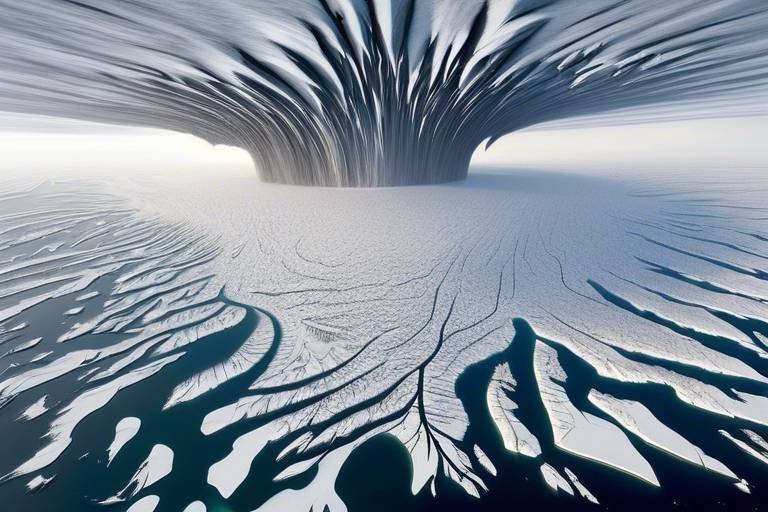The Dangers of Ocean Acidification due to Climate Change
Ocean acidification is one of the most pressing environmental challenges we face today, and it’s largely a consequence of climate change. As our planet warms, the oceans absorb a significant portion of the carbon dioxide (CO2) emitted into the atmosphere. This process, while initially seeming beneficial as it helps to reduce greenhouse gases, actually leads to a series of detrimental effects on marine ecosystems. Imagine the ocean as a giant sponge, soaking up CO2, but in doing so, it becomes more acidic. This shift in pH levels can have catastrophic consequences for marine life and, ultimately, for human society.
The chemistry behind ocean acidification is straightforward yet alarming. When CO2 dissolves in seawater, it reacts with water molecules to form carbonic acid, which then dissociates into bicarbonate and hydrogen ions. The increase in hydrogen ions lowers the pH of the water, making it more acidic. This change can disrupt the delicate balance of marine ecosystems, affecting everything from the smallest plankton to the largest whales. It’s a ripple effect that can lead to significant biodiversity loss and altered food webs, which are critical for the health of our oceans and the livelihoods of millions of people who depend on them.
To truly grasp the significance of ocean acidification, we need to look at its broader implications. The ocean is often referred to as the "lungs of the Earth," producing over half of the oxygen we breathe. However, as the ocean becomes more acidic, its ability to support life diminishes. Coral reefs, often called the rainforests of the sea due to their biodiversity, are particularly vulnerable. They rely on calcium carbonate to build their skeletons, and as acidity increases, the availability of carbonate ions decreases, making it harder for corals to grow and thrive. This not only threatens coral reefs but also the myriad species that rely on them for habitat and food.
In addition to coral reefs, shellfish populations are also at risk. Oysters, clams, and other shellfish struggle to form their shells in more acidic waters, leading to declines in their populations. This is not just an environmental concern; it has direct economic implications for coastal communities that rely on fishing and aquaculture. As these species decline, so do the livelihoods of those who depend on them, creating a domino effect that can impact local economies and food security.
Moreover, ocean acidification doesn't just stop at marine life; it extends to human health as well. As the chemistry of the ocean changes, so does the quality of the seafood we consume. Contaminants can accumulate in marine organisms, leading to potential health risks for humans who eat them. This raises urgent questions about food safety and the need for stringent monitoring and regulations to protect public health.
- What is ocean acidification? Ocean acidification refers to the decrease in pH levels of the ocean due to the absorption of CO2 from the atmosphere, resulting in more acidic waters.
- How does ocean acidification affect marine life? It disrupts the ability of marine organisms, particularly those with calcium carbonate shells or skeletons, to grow and thrive, leading to declines in biodiversity.
- What are the economic impacts of ocean acidification? Fisheries and tourism industries can suffer significantly due to declining marine health, affecting local economies and livelihoods.
- How can we mitigate ocean acidification? Reducing CO2 emissions and promoting sustainable practices are critical strategies to combat ocean acidification.
- What are the health risks associated with ocean acidification? Changes in ocean chemistry can lead to the accumulation of contaminants in seafood, posing health risks to humans who consume affected marine life.

Understanding Ocean Acidification
Ocean acidification is a term that might sound like a complex scientific concept, but at its core, it’s quite simple: it refers to the decrease in pH levels of the ocean, primarily caused by the absorption of carbon dioxide (CO2) from the atmosphere. Imagine the ocean as a giant sponge, soaking up excess CO2 like a thirsty plant. While this may seem harmless at first, it leads to significant changes in the ocean's chemistry, resulting in a cascade of effects that can be detrimental to marine life.
To grasp the importance of ocean acidification, we need to understand the basic science behind it. When CO2 dissolves in seawater, it reacts with water to form carbonic acid, which subsequently dissociates into bicarbonate and hydrogen ions. This process lowers the pH of the ocean, making it more acidic. A lower pH can disrupt the delicate balance of marine ecosystems, where organisms like corals, shellfish, and plankton struggle to maintain their calcium carbonate structures, essential for their survival. It’s like trying to build a house with crumbling bricks; the foundation simply won’t hold.
As ocean acidification progresses, it poses a serious threat to the biodiversity of marine ecosystems. Scientists have observed that the current rate of acidification is unprecedented in the last 300 million years. This rapid change is alarming because many marine species are not adapted to such swift environmental shifts. For example, coral reefs, often referred to as the "rainforests of the sea," are particularly vulnerable. These ecosystems are not only beautiful but also provide habitat for countless marine species, support fisheries, and protect coastlines from erosion. The health of coral reefs is a direct indicator of ocean health, and their decline signals a broader ecological crisis.
Furthermore, the implications of ocean acidification extend beyond marine life. It has profound effects on global fisheries, which are crucial for food security and the livelihoods of millions of people worldwide. As shellfish populations decline due to their inability to form shells in more acidic waters, communities that rely on these resources face economic hardships. This situation raises an important question: how do we balance our carbon footprint with the health of our oceans?
In summary, understanding ocean acidification is essential for grasping the broader narrative of climate change. It’s not just about warmer waters or rising sea levels; it’s also about the chemistry of our oceans and the life they support. By recognizing the significance of this issue, we can better appreciate the urgency of addressing climate change and protecting our marine ecosystems.

Causes of Ocean Acidification
Ocean acidification is a serious environmental issue, and understanding its causes is crucial to addressing the problem effectively. At the heart of this alarming phenomenon lies the increase in atmospheric carbon dioxide (CO2) levels, primarily driven by human activities. When we burn fossil fuels for energy, transportation, and industrial processes, we release vast amounts of CO2 into the atmosphere. This gas doesn't just hang around; a significant portion of it is absorbed by the oceans, leading to a chemical reaction that lowers the pH of seawater. In essence, the ocean acts like a sponge, soaking up excess CO2, but this comes at a cost.
To illustrate the gravity of this situation, consider the following key sources of CO2 emissions:
- Fossil Fuel Combustion: The burning of coal, oil, and natural gas for electricity and heat is the largest single source of global CO2 emissions. This process releases billions of tons of CO2 each year, significantly contributing to ocean acidification.
- Deforestation: Trees play a vital role in absorbing CO2 from the atmosphere. When forests are cut down, not only is this natural carbon sink removed, but the carbon stored in trees is also released back into the atmosphere, further exacerbating the problem.
- Industrial Processes: Certain manufacturing processes, such as cement production, also release substantial amounts of CO2. These activities contribute to the overall greenhouse gas emissions that lead to ocean acidification.
As CO2 levels rise, a chemical reaction occurs when this gas dissolves in seawater, forming carbonic acid. This acid dissociates into bicarbonate and hydrogen ions, leading to an increase in hydrogen ion concentration and a corresponding decrease in pH. The ocean's average pH has already dropped from about 8.2 to approximately 8.1 since the beginning of the industrial revolution, representing a more than 30% increase in acidity. This change, while seemingly small, can have devastating effects on marine life.
Moreover, as we continue to rely heavily on fossil fuels, the situation will only worsen. It's like pouring more and more sugar into a glass of water; eventually, it becomes too saturated to dissolve any more. Similarly, the ocean can only absorb so much CO2 before the effects become catastrophic. The urgency to transition to renewable energy sources and adopt sustainable practices cannot be overstated. Failure to do so not only jeopardizes marine ecosystems but also threatens the very foundation of human life that depends on these resources.
In conclusion, the causes of ocean acidification are deeply intertwined with our daily choices and global energy policies. By understanding these causes, we can begin to take meaningful action to mitigate their impact. It's not just about saving the oceans; it's about ensuring a healthy planet for future generations.

Role of Fossil Fuels
Fossil fuels are the backbone of our modern energy system, but they come with a hefty price tag for the environment. The combustion of coal, oil, and natural gas releases vast amounts of carbon dioxide (CO2) into the atmosphere, a significant driver of ocean acidification. When CO2 is emitted, approximately 30% of it is absorbed by the oceans, leading to a chemical reaction that lowers the pH of seawater. This process is akin to pouring sugar into a cup of tea; just as the sugar dissolves and alters the flavor, CO2 alters the ocean's chemistry, making it more acidic and less hospitable to marine life.
The reliance on fossil fuels is not just an environmental concern; it's a complex web of economic and social implications. For instance, industries that depend on fossil fuels for energy often prioritize short-term profits over long-term sustainability. This creates a cycle where the environmental impacts are ignored until they become too severe to overlook. The urgency of the situation is palpable, as scientists warn that continued reliance on fossil fuels could lead to catastrophic changes in ocean ecosystems. The question is: how long can we afford to ignore these warnings?
To better understand the extent of fossil fuel consumption and its impact on ocean acidification, consider the following table that outlines the major sources of CO2 emissions:
| Source of Emissions | Annual CO2 Emissions (in billion tons) |
|---|---|
| Coal | 14.5 |
| Oil | 11.5 |
| Natural Gas | 6.0 |
| Total | 32.0 |
As illustrated in the table, coal remains the largest contributor to CO2 emissions, followed closely by oil and natural gas. This highlights the pressing need for a shift towards renewable energy sources like solar, wind, and hydroelectric power. These alternatives not only reduce our carbon footprint but also offer a sustainable solution to the growing problem of ocean acidification.
In conclusion, the role of fossil fuels in ocean acidification is undeniable. As we continue to extract and burn these resources, the health of our oceans hangs in the balance. The time for change is now, and it requires a collective effort from individuals, industries, and governments to transition towards cleaner energy solutions. Are we ready to make that leap?
- What is ocean acidification? Ocean acidification refers to the decrease in pH levels of the ocean due to increased absorption of CO2 from the atmosphere.
- How do fossil fuels contribute to ocean acidification? The burning of fossil fuels releases CO2 into the atmosphere, which is then absorbed by the oceans, leading to increased acidity.
- What are the impacts of ocean acidification on marine life? Ocean acidification negatively affects marine organisms, particularly those with calcium carbonate structures like coral and shellfish, disrupting ecosystems.
- What can be done to mitigate ocean acidification? Mitigation strategies include reducing CO2 emissions, transitioning to renewable energy sources, and promoting sustainable fishing practices.

Impact on Marine Ecosystems
The effects of ocean acidification on marine ecosystems are profound and far-reaching, acting like a ripple in a pond that expands outward, affecting all life forms within it. As the ocean absorbs more carbon dioxide (CO2), the water becomes more acidic, altering the delicate balance that sustains marine life. This change in chemistry can disrupt the very foundation of marine ecosystems, leading to a cascade of consequences that threaten biodiversity and ecological stability.
One of the most vulnerable groups to ocean acidification are coral reefs, often referred to as the "rainforests of the sea." These vibrant ecosystems rely on calcium carbonate to build their structures. As the ocean becomes more acidic, the availability of carbonate ions diminishes, making it difficult for corals to grow and maintain their skeletons. The decline of coral reefs not only affects the myriad of species that depend on them for habitat but also jeopardizes the livelihoods of millions of people who rely on these ecosystems for food and tourism.
In addition to corals, shellfish such as oysters, clams, and mussels are also at risk. These organisms use calcium carbonate to form their shells, and as the ocean becomes more acidic, their ability to produce and maintain these shells is compromised. A decline in shellfish populations can have dire consequences for marine food webs, as many species, including fish, rely on them as a primary food source. This disruption can lead to reduced fish populations, impacting both biodiversity and commercial fisheries, which are vital to many coastal communities.
Moreover, ocean acidification can alter the behavior and physiology of marine organisms. For instance, studies have shown that increased acidity can affect the sensory perception of fish, impairing their ability to detect predators and find food. This can lead to a decline in fish populations, further destabilizing the food web and affecting species diversity. As these changes unfold, the intricate relationships among species—predator and prey, symbiotic partnerships, and competition for resources—are thrown into disarray, creating an environment where survival becomes increasingly challenging.
To illustrate the potential impacts of ocean acidification on marine ecosystems, consider the following table that highlights key affected species and their roles:
| Species | Impact of Ocean Acidification | Ecological Role |
|---|---|---|
| Coral Reefs | Reduced growth and structural integrity | Habitat for diverse marine life |
| Shellfish (Oysters, Clams) | Difficulty in shell formation | Food source for fish and humans |
| Fish (e.g., Clownfish) | Altered behavior and sensory perception | Predators and prey in marine food webs |
In conclusion, the impact of ocean acidification on marine ecosystems is a complex and multifaceted issue. The decline of coral reefs and shellfish populations, along with the changes in fish behavior, underscore the urgent need for action to mitigate CO2 emissions and protect our oceans. If we continue on this path without addressing the root causes, we risk not only the health of marine ecosystems but also the future of human societies that depend on them.
- What is ocean acidification? Ocean acidification refers to the decrease in pH levels of the ocean, primarily caused by the absorption of carbon dioxide from the atmosphere.
- How does ocean acidification affect marine life? It disrupts the ability of marine organisms, like corals and shellfish, to maintain their structures, leading to declines in biodiversity and ecological balance.
- What can be done to mitigate ocean acidification? Reducing carbon emissions, promoting sustainable practices, and protecting marine environments are essential steps to address this issue.
- Why should we care about ocean acidification? The health of marine ecosystems is crucial for food security, livelihoods, and the overall health of our planet.

Economic Consequences
The economic implications of ocean acidification are profound and far-reaching, impacting not just marine ecosystems but also the livelihoods of countless individuals and communities around the globe. Imagine a world where vibrant coral reefs turn into barren wastelands; this scenario is not just a nightmare for marine life but also a potential reality for those who depend on these ecosystems for their economic survival. The decline in marine health can lead to significant challenges for industries that rely on ocean resources, particularly fisheries and tourism.
Fisheries, which are vital for food security and employment in many coastal regions, are especially vulnerable. As ocean acidification alters the chemical composition of seawater, it disrupts the growth and survival of shellfish and other marine species. For instance, mollusks like oysters and clams struggle to form their shells in more acidic waters. This decline not only affects the marine population but also the fishing industry that relies on these species. According to recent studies, a decrease in shellfish populations could lead to a staggering loss of revenue for fisheries, potentially reaching billions of dollars globally.
Furthermore, the tourism industry, which thrives on the beauty and biodiversity of marine environments, is also at risk. Coastal tourism, including activities like snorkeling and scuba diving, heavily depends on healthy coral reefs and diverse marine life. As these ecosystems deteriorate, tourists may choose to visit other destinations, leading to a decline in local economies that rely on tourism dollars. In fact, some regions could see a drop in tourism revenue by as much as 30% or more if current trends continue. This decline can lead to job losses and reduced income for communities that depend on tourism.
To illustrate the economic impact of ocean acidification, consider the following table, which shows projected revenue losses in key industries affected by declining marine health:
| Industry | Projected Revenue Loss (Billions) | Impact on Employment |
|---|---|---|
| Fisheries | $10 - $20 | Millions of jobs at risk |
| Tourism | $5 - $15 | Hundreds of thousands of jobs |
| Coastal Real Estate | $3 - $8 | Variable, depending on location |
As we can see, the ripple effects of ocean acidification extend far beyond the water's surface, touching every aspect of human life that is intertwined with the ocean. The urgency to take action cannot be overstated. If we do not address the root causes of ocean acidification, we risk not only the health of our oceans but also the economic stability of communities that depend on them. It's a call to arms for policymakers, businesses, and individuals alike to come together and forge a sustainable path forward.
- What is ocean acidification? Ocean acidification refers to the decrease in pH levels of the ocean due to increased absorption of carbon dioxide (CO2) from the atmosphere.
- How does ocean acidification affect marine life? It disrupts the growth and survival of marine organisms, particularly those with calcium carbonate shells, such as shellfish and coral.
- What are the economic impacts of ocean acidification? It leads to significant revenue losses in fisheries and tourism, affecting jobs and livelihoods in coastal communities.
- What can be done to mitigate ocean acidification? Reducing CO2 emissions, promoting sustainable fishing practices, and protecting marine habitats are crucial steps.

Mitigation Strategies
Addressing the pressing issue of ocean acidification is not just a task for scientists and policymakers; it requires the collective effort of individuals, communities, and nations around the globe. The reality is that we are at a critical juncture where the choices we make today will shape the health of our oceans for generations to come. So, what can we do to mitigate this phenomenon?
First and foremost, we must focus on reducing carbon dioxide emissions. This can be achieved through a variety of means, including transitioning to renewable energy sources such as solar, wind, and hydroelectric power. By decreasing our reliance on fossil fuels, we can significantly lower the amount of CO2 that enters the atmosphere and subsequently the oceans. In fact, a global shift to renewable energy could cut emissions by up to 70% by 2050. Isn't that an astonishing figure?
Moreover, promoting energy efficiency in our daily lives can also make a significant impact. Simple actions like using energy-efficient appliances, reducing water heating temperatures, and opting for public transportation can collectively lead to substantial reductions in emissions. When we all do our part, it adds up to something much larger. Imagine if everyone in your community committed to energy-saving practices—what a difference it would make!
Another critical strategy involves restoring and protecting marine ecosystems. Healthy ecosystems, such as mangroves, seagrasses, and coral reefs, can act as natural buffers against ocean acidification. They absorb CO2 and help maintain the delicate balance of marine environments. Conservation efforts, including creating marine protected areas (MPAs), can safeguard these vital ecosystems. For instance, studies have shown that MPAs can enhance biodiversity and resilience in marine habitats, allowing them to better withstand the pressures of climate change.
Furthermore, supporting sustainable fishing practices is crucial. Overfishing and destructive fishing methods not only deplete fish stocks but also disrupt the entire marine food web. By choosing sustainably sourced seafood, consumers can drive demand for responsible fishing practices, which in turn supports healthier oceans. Initiatives like the Marine Stewardship Council (MSC) certification help consumers identify sustainable seafood options, giving them the power to make informed choices.
Lastly, we cannot underestimate the importance of education and awareness. Informing the public about the impacts of ocean acidification and climate change can foster a sense of responsibility and urgency. Schools, community organizations, and social media platforms can be powerful tools in spreading knowledge and encouraging action. When people understand the stakes, they are more likely to advocate for policies that protect our oceans and engage in sustainable practices.
In summary, the fight against ocean acidification is multifaceted and requires a holistic approach. By reducing CO2 emissions, protecting marine ecosystems, supporting sustainable practices, and educating ourselves and others, we can make strides toward a healthier ocean. It’s about taking action today to ensure a vibrant marine environment for tomorrow. So, what will you do to be part of the solution?
- What is ocean acidification? Ocean acidification is the process by which the ocean becomes more acidic due to increased CO2 absorption from the atmosphere.
- How does ocean acidification affect marine life? It negatively impacts marine organisms, especially those with calcium carbonate shells or skeletons, such as corals and shellfish, disrupting ecosystems.
- What can individuals do to help? Individuals can reduce their carbon footprint by using renewable energy, conserving energy, supporting sustainable seafood, and advocating for marine conservation.
- Why is education important in combating ocean acidification? Education raises awareness about the issue, empowering individuals to take action and advocate for policies that protect marine environments.

Effects on Human Health
Ocean acidification is not just a problem for marine life; it has real and concerning implications for human health as well. As the oceans absorb increasing amounts of carbon dioxide (CO2), the chemical balance of seawater shifts, leading to a host of environmental changes that can directly or indirectly affect human populations. One of the most pressing issues is the impact on food security, especially in coastal communities that rely heavily on seafood as a primary source of nutrition. When shellfish and other marine organisms struggle to survive in more acidic waters, the availability of these vital food sources diminishes, leading to nutritional deficiencies and increased food prices.
Moreover, the decline in marine biodiversity due to ocean acidification can disrupt entire ecosystems, which in turn affects the livelihoods of those who depend on fishing and aquaculture. Imagine a world where the vibrant seafood markets are replaced with empty stalls; this is a potential reality if we do not address the issue of ocean acidification. The repercussions extend beyond economics; they touch the very essence of food culture and community identity for many coastal societies.
Additionally, there are public health concerns associated with the consumption of marine life that has been affected by ocean acidification. As the chemistry of the ocean changes, it can lead to the proliferation of harmful algal blooms, which produce toxins that accumulate in seafood. When humans consume contaminated shellfish or fish, they may face serious health risks, including:
- Neurological issues from neurotoxins
- Gastrointestinal illnesses
- Long-term health complications from chronic exposure
These health risks necessitate rigorous monitoring and regulation of marine ecosystems to ensure that seafood remains safe for consumption. Public health officials and environmental scientists must work hand in hand to develop strategies for monitoring ocean health and managing fisheries sustainably. Without these measures, communities may find themselves facing both food insecurity and health crises, creating a vicious cycle that is difficult to break.
In summary, the effects of ocean acidification on human health are multifaceted and profound. From food security risks to public health concerns, the implications are far-reaching. It is imperative to recognize that our health is interconnected with the health of our oceans, and as stewards of the planet, we must take action to mitigate these risks. The future of both marine ecosystems and human populations depends on our collective ability to address these pressing challenges.
Q1: How does ocean acidification affect seafood safety?
A1: Ocean acidification can lead to harmful algal blooms that produce toxins, which accumulate in shellfish and fish, posing health risks to humans who consume them.
Q2: What are the long-term effects of consuming contaminated seafood?
A2: Long-term consumption of contaminated seafood can lead to serious health issues, including neurological problems and gastrointestinal illnesses.
Q3: How can communities protect themselves from the effects of ocean acidification?
A3: Communities can engage in sustainable fishing practices, support local regulations on marine health, and advocate for policies aimed at reducing CO2 emissions.
Q4: What role do governments play in addressing ocean acidification?
A4: Governments can implement policies to monitor ocean health, regulate emissions, and promote sustainable practices to protect marine ecosystems and public health.

Food Security Risks
As we dive deeper into the implications of ocean acidification, one of the most alarming issues that surfaces is the potential threat to food security. Imagine the ocean as a vast grocery store, brimming with nutritious seafood that feeds millions of people around the globe. However, as the waters become more acidic, this essential food source is at risk of dwindling. The decline in shellfish populations, such as oysters and clams, is particularly concerning. These creatures are not just culinary delights; they play a crucial role in our diets, especially for coastal communities that rely heavily on them for sustenance.
To put it into perspective, consider that shellfish are a significant source of protein and other vital nutrients for many populations. The impact of ocean acidification on these species can lead to a ripple effect, jeopardizing the food security of communities that depend on them. The following points illustrate some of the key risks associated with this phenomenon:
- Declining Shellfish Populations: As the acidity of the ocean increases, the ability of shellfish to build and maintain their calcium carbonate shells diminishes. This not only affects their survival but also their reproduction rates.
- Impact on Fisheries: Many fish species rely on shellfish as a primary food source. A decline in shellfish populations can disrupt the entire marine food web, leading to decreased fish stocks and, consequently, fewer fish available for human consumption.
- Economic Strain: Communities that depend on fishing and shellfish harvesting for their livelihoods face economic challenges as these resources become scarcer. This can lead to increased prices for seafood, making it less accessible for those who rely on it.
Moreover, the decline in marine biodiversity due to ocean acidification can lead to less resilient ecosystems. A healthy ocean is a balanced one, where various species coexist and support one another. When certain species begin to vanish, it can create a domino effect that further destabilizes the marine environment, making it harder for remaining species to thrive. This situation not only threatens the food supply but also the cultural practices and traditions tied to fishing and seafood consumption.
In light of these challenges, it becomes clear that addressing ocean acidification is not just an environmental issue; it’s a matter of food security and public health. Coastal communities, often already vulnerable, may find themselves facing a double whammy of dwindling resources and rising costs. As we consider the future of our oceans and the food they provide, we must recognize the urgent need for comprehensive strategies that not only mitigate acidification but also support sustainable fishing practices and protect the livelihoods of those who rely on these vital resources.
- What is ocean acidification? Ocean acidification is the process by which the ocean becomes more acidic due to increased levels of carbon dioxide (CO2) in the atmosphere, which is absorbed by seawater.
- How does ocean acidification affect marine life? It primarily affects organisms that rely on calcium carbonate to build their shells and skeletons, such as shellfish and corals, leading to decreased populations and biodiversity.
- What can be done to mitigate ocean acidification? Strategies include reducing CO2 emissions, transitioning to renewable energy sources, and promoting sustainable fishing practices.
- Why is food security at risk due to ocean acidification? As shellfish populations decline and fish stocks are disrupted, communities that rely on these resources for their diets and livelihoods face significant challenges.

Public Health Concerns
As we dive deeper into the murky waters of ocean acidification, it’s crucial to recognize that the implications extend far beyond the waves. The changes in ocean chemistry not only threaten marine ecosystems but also pose significant public health risks for humans. Imagine the ocean as a vast pantry, providing nourishment and sustenance to millions. When that pantry begins to spoil, the consequences can be dire.
One of the most pressing issues is the contamination of seafood. As ocean acidity increases, it can lead to the proliferation of harmful algal blooms, commonly known as red tides. These blooms produce toxins that can accumulate in shellfish and other marine organisms, posing serious health risks to those who consume them. For coastal communities that rely heavily on seafood for their diets and economies, this is not just an environmental concern; it’s a matter of survival.
Moreover, the decline in shellfish populations due to acidification can exacerbate food insecurity. Shellfish, such as oysters and clams, are not only a vital source of protein but also contribute essential nutrients to our diets. A decrease in their availability can lead to nutritional deficiencies, particularly in communities that depend on these organisms for sustenance. This situation creates a vicious cycle where the health of the ocean directly impacts human health.
In addition to the direct health risks from contaminated seafood, there are broader implications for public health systems. Increased cases of foodborne illnesses linked to toxic seafood can place additional strain on healthcare resources. For instance, if a community experiences a spike in hospital visits due to seafood poisoning, the local healthcare system may become overwhelmed, diverting resources from other critical areas.
To further illustrate the potential health risks, consider the following table that outlines some of the common toxins associated with harmful algal blooms and their effects:
| Toxin | Source | Health Effects |
|---|---|---|
| Domonic Acid | Marine Diatoms | Diarrhetic shellfish poisoning, gastrointestinal issues |
| Saxitoxin | Dinoflagellates | Paralytic shellfish poisoning, neurological symptoms |
| Okadaic Acid | Dinoflagellates | Diarrhetic shellfish poisoning, nausea, and vomiting |
As we can see, the health risks associated with ocean acidification are not just theoretical; they are tangible threats that demand immediate attention. It’s essential for governments and health organizations to monitor marine environments and establish regulations to safeguard public health. This includes implementing rigorous testing of seafood and educating communities about the risks associated with consuming potentially contaminated marine life.
In conclusion, while ocean acidification may seem like an environmental issue confined to the depths of the sea, its repercussions ripple through our lives in profound ways. By understanding the public health concerns linked to this phenomenon, we can better advocate for policies that protect both our oceans and our health. After all, a healthy ocean is a cornerstone of a healthy society.
- What is ocean acidification? Ocean acidification refers to the decrease in pH levels of the ocean due to increased absorption of atmospheric CO2.
- How does ocean acidification affect human health? It can lead to contaminated seafood, which poses health risks, and can also affect food security and nutrition.
- What are harmful algal blooms? Harmful algal blooms are rapid growths of algae that can produce toxins harmful to marine life and humans.
- What can be done to mitigate ocean acidification? Reducing CO2 emissions and promoting sustainable practices are critical steps in addressing this issue.
Frequently Asked Questions
- What is ocean acidification?
Ocean acidification is the process where the ocean becomes more acidic due to increased levels of carbon dioxide (CO2) in the atmosphere. When CO2 is absorbed by seawater, it reacts with water to form carbonic acid, which lowers the pH of the ocean. This change in chemistry can have detrimental effects on marine life and ecosystems.
- What causes ocean acidification?
The primary cause of ocean acidification is the rise in atmospheric CO2 levels, primarily from human activities such as burning fossil fuels, deforestation, and industrial processes. These activities release large amounts of CO2 into the atmosphere, which is then absorbed by the oceans, leading to a decrease in pH levels.
- How does ocean acidification impact marine ecosystems?
Ocean acidification disrupts marine ecosystems by affecting the ability of organisms like corals and shellfish to build their shells and skeletons. This can lead to a decline in biodiversity, alter food webs, and ultimately threaten the survival of various marine species that are crucial for ecological balance.
- What are the economic implications of ocean acidification?
The economic consequences of ocean acidification are significant, particularly for industries reliant on healthy marine ecosystems, such as fisheries and tourism. Declining fish stocks and damaged coral reefs can lead to reduced catches, loss of livelihoods, and decreased tourism revenue for coastal communities.
- How can we mitigate ocean acidification?
Mitigating ocean acidification requires global efforts to reduce CO2 emissions. This can be achieved through transitioning to renewable energy sources, promoting energy efficiency, and implementing sustainable practices in agriculture and industry. Protecting marine environments through conservation efforts also plays a crucial role.
- What are the human health risks associated with ocean acidification?
Ocean acidification can impact human health by affecting food security and increasing the risk of consuming contaminated marine life. As shellfish populations decline, communities that rely on them for nutrition may face food shortages. Additionally, pollutants in acidified waters can lead to health issues, necessitating monitoring and regulation.
- How does ocean acidification affect food security?
The decline in shellfish and other marine species due to ocean acidification poses significant risks to food security, especially for coastal communities that depend on these resources. As these populations dwindle, the availability of nutritious food decreases, which can lead to malnutrition and increased food insecurity.



















